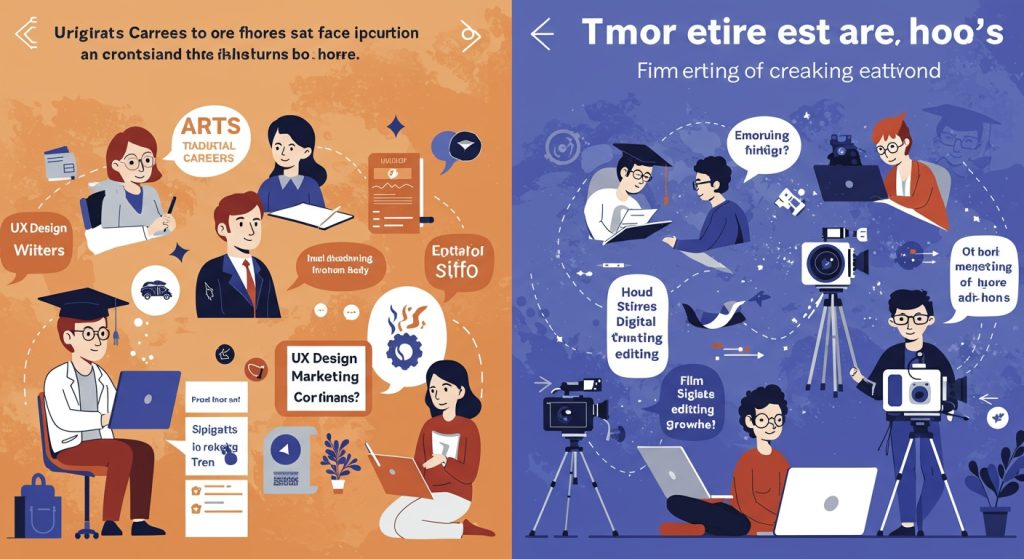The contemporary career landscape presents unprecedented complexity for university students. Rapid technological advancements, from artificial intelligence to blockchain, continuously redefine job roles and industry demands. Traditional linear career trajectories increasingly yield to dynamic, portfolio-based work and interdisciplinary specializations. Navigating this evolving environment demands a strategic approach, integrating self-assessment with rigorous market analysis. Undecided students must actively deconstruct prevailing labor market trends, identifying emerging opportunities and requisite skill sets, rather than passively awaiting a singular, perfect fit. This proactive methodology empowers students to construct adaptable career frameworks.

The Weight of Indecision: Why It’s Normal to Feel Lost
Stepping into university can feel like stepping onto a vast, open ocean. You’re equipped with academic ambition. For many, the destination – a clear career path – remains shrouded in mist. If you’re an undecided university student grappling with career choices, know this: you are far from alone. This feeling of indecision is incredibly common and, in many ways, it’s a valuable part of your growth journey.
The pressure to choose a career path can feel immense. Society often presents a linear narrative: study X, become Y. But, the modern world is dynamic, with new industries emerging constantly and traditional roles evolving. This complexity, while exciting, can also be overwhelming, leading to analysis paralysis. Moreover, university is a time of profound self-discovery. Your interests, values. Strengths are still developing, making it challenging to commit to a singular professional identity.
Embrace this period of exploration. It’s not a sign of weakness. An opportunity to build a robust foundation for a fulfilling professional life. Instead of viewing indecision as a problem, consider it a chance to engage deeply with self-assessment and informed exploration, laying the groundwork for effective career guidance.
Decoding Yourself: The Power of Self-Assessment
Before you can identify a career that fits, you need to grasp the unique individual you are. Self-assessment is the cornerstone of effective career guidance, providing clarity on what truly motivates you and where your natural talents lie. This isn’t about finding a label; it’s about understanding your internal compass.
- Interests
- Skills
- Values
- Personality
- Myers-Briggs Type Indicator (MBTI)
- Holland Codes (RIASEC)
- CliftonStrengths (formerly StrengthsFinder)
What genuinely excites you? What topics do you find yourself researching in your free time? What activities make you lose track of time? Your passions, even if they seem unrelated to traditional careers, can often be threads leading to fulfilling work. For example, a love for video games might lead to careers in game design, coding, storytelling, or even user experience research.
What are you good at? This includes both ‘hard skills’ (like coding, writing, data analysis, speaking a foreign language) and ‘soft skills’ (like communication, problem-solving, teamwork, adaptability, critical thinking). Reflect on academic projects, extracurricular activities, part-time jobs. Even hobbies. You might excel at organizing events, breaking down complex insights, or empathizing with others – all highly valuable professional skills.
What truly matters to you in a career and in life? Do you prioritize financial stability, making a social impact, creative expression, work-life balance, continuous learning, or autonomy? Understanding your core values helps you filter out careers that might not align with your deepest convictions, even if they seem appealing on the surface. For instance, someone valuing social impact might find more satisfaction in non-profit work than in a high-paying corporate job.
How do you interact with the world, process data. Make decisions? Personality assessments, when used as tools for self-reflection rather than definitive labels, can offer insights.
Categorizes preferences in four dichotomies (e. G. , Introversion/Extraversion, Sensing/Intuition). While sometimes debated in its scientific rigor, it can be a useful starting point for understanding your natural inclinations in work environments.
Developed by John Holland, this theory suggests that people and work environments can be classified into six basic types: Realistic, Investigative, Artistic, Social, Enterprising. Conventional. Matching your dominant types to careers can suggest suitable paths. For example, a “Social” type might thrive in teaching or counseling.
Focuses on identifying your top five natural talents, helping you interpret where you have the greatest potential for excellence.
Keep a “discovery journal” where you jot down insights from your daily experiences, reflections on your interests. Observations about what energizes or drains you. Consider taking a reputable online self-assessment through your university’s career services or a trusted platform, always remembering they are guides, not definitive answers.
Beyond the Brochure: Researching Career Paths Effectively
Once you have a clearer picture of yourself, it’s time to explore the vast landscape of career options. This goes beyond simply reading job descriptions; it involves active investigation to interpret the day-to-day realities, required skills. Growth potential of various fields.
- Online Exploration
- Reputable Career Websites
- Industry Reports and News
- Informational Interviews
- How to Conduct
- Benefits
- Internships & Volunteering
- Job Shadowing
- Networking
Sites like LinkedIn, Glassdoor, Indeed. Government labor statistics bureaus (e. G. , U. S. Bureau of Labor Statistics Occupational Outlook Handbook) offer detailed details on job roles, required education, median salaries. Job outlook.
Stay updated on trends in fields that interest you. Publications like the Wall Street Journal, industry-specific blogs. Professional association websites can provide deep insights.
This is arguably one of the most powerful tools. An informational interview is a brief conversation (15-30 minutes) with someone working in a field or role that interests you. The goal is not to ask for a job. To gather insights, learn about their experiences. Gain insights into their daily work, challenges. Career trajectory.
Reach out via LinkedIn or university alumni networks. Prepare thoughtful questions like: “What does a typical day look like for you?” , “What are the biggest challenges in your role?” , “What skills are most vital for success in this field?”. “What advice would you give to someone starting out?”
Provides authentic, unfiltered insights that you can’t get from online research. It helps you build your professional network and often uncovers career paths you hadn’t considered.
Nothing beats hands-on experience. Internships, even short-term ones, allow you to “test drive” a career path. They provide real-world exposure, help you develop practical skills. Allow you to build professional connections. Volunteering can offer similar benefits, particularly in the non-profit sector. Can be more flexible.
If an internship isn’t feasible, ask to shadow someone for a day or two. This provides a direct observation of a professional’s routine and work environment.
Actively building a professional network by attending career fairs, workshops. Industry events, both online and offline. Every connection is a potential source of insights and future opportunity. Your university’s career guidance office is an excellent starting point for finding these events.
Case Study: Emily’s Discovery
Emily, a second-year university student, was torn between majoring in English Literature and Business. She loved reading and writing but also felt a pull towards the corporate world. Instead of agonizing, she decided to take action. She conducted informational interviews with a marketing manager, a technical writer. A literary agent. The marketing manager’s description of strategic planning and creative campaigns resonated deeply. She then pursued a summer internship in a marketing department, which confirmed her interest. This hands-on experience, coupled with the insights from her interviews, provided invaluable career guidance and helped her confidently choose a Business major with a marketing concentration.
Making the Leap: Strategies for Decision-Making
Once you’ve gathered insights about yourself and potential careers, the next step is to synthesize it and make informed decisions. This isn’t about finding the ‘perfect’ path. Rather the ‘best fit for now,’ with the understanding that your path may evolve.
- Pros and Cons List
- Trial and Error
- Mentorship
- University Career Services
- Personalized counseling sessions to help you interpret self-assessment results and explore options.
- Resume and cover letter reviews.
- Mock interviews to prepare you for job applications.
- Networking events and job boards specific to your university’s alumni and employer connections.
- Workshops on various career-related topics.
- Short-Term vs. Long-Term Goals
A classic but effective tool. For each potential career path, list the advantages (e. G. , aligns with values, good salary, interesting work) and disadvantages (e. G. , long hours, extensive education required, high stress). This visual comparison can highlight patterns and preferences.
It’s okay to experiment. Your first choice of major or internship doesn’t have to be your last. University is the ideal time to try different courses, join various clubs, or take on diverse part-time jobs. Each experience, even if it confirms what you don’t want, brings you closer to what you do.
Seek out mentors – individuals who have experience in fields you’re considering. A mentor can offer personalized advice, share their journey. Help you navigate challenges. This informal career guidance can be incredibly reassuring and insightful.
Your university’s career center is an invaluable resource for structured career guidance. They offer:
Balance immediate next steps (e. G. , choosing a major, finding an internship) with your long-term aspirations. Sometimes, a “stepping stone” role or major can lead to your ultimate goal. Don’t feel pressured to have your entire 40-year career mapped out. Focus on the next logical step that aligns with your current understanding of yourself.
| Approach | Description | Pros | Cons |
|---|---|---|---|
| Analytical (e. G. , Pros/Cons) | Systematic evaluation of options based on objective criteria. | Clear structure, logical, reduces emotional bias. | Can be overwhelming with too many factors, may overlook intangible aspects. |
| Experiential (e. G. , Internships, Trials) | Learning by doing, testing out paths in real-world settings. | Authentic insights, practical skill development, builds network. | Time-consuming, may require commitment to a path that isn’t a perfect fit initially. |
| Intuitive (Gut Feeling) | Making choices based on what “feels right” after reflection. | Quick, taps into subconscious understanding. | Can be influenced by bias, lacks concrete justification. |
| Consultative (e. G. , Mentors, Counselors) | Seeking advice and perspectives from experienced individuals. | Gains from others’ wisdom, personalized insights, builds confidence. | Advice may not always align with your unique situation, depends on mentor’s availability. |
Navigating the Unexpected: Flexibility and Resilience
The idea of choosing a “forever” career path is a myth. The professional landscape is constantly shifting. So are individuals. Embracing flexibility and building resilience are crucial for a successful and fulfilling career journey.
- The Myth of the “Perfect” Path
- Embracing Change
- Continuous Learning
- Building a ‘Portfolio Career’
- When to Pivot
No career path is without its challenges or compromises. The goal is to find a path that offers a good fit, where your strengths are utilized, your values are respected. You feel engaged. It’s about finding satisfaction, not perfection.
Careers evolve. So should your approach. Be open to new opportunities, even if they deviate from your initial plan. A degree in one field can often open doors to completely different industries. For example, a philosophy major might excel in law, tech ethics, or strategic consulting due to their critical thinking skills.
The most successful professionals are lifelong learners. Whether it’s through formal education, online courses, certifications, or self-study, continuously acquiring new skills and knowledge is essential to stay relevant and adaptable. This also enables you to pivot more easily if your interests or the job market changes.
Many people are moving towards a “portfolio career,” where they combine different roles, projects, or part-time jobs that utilize diverse skills and interests. This could involve freelance work, consulting, or even balancing a traditional job with a passion project. This approach offers variety, autonomy. The ability to explore multiple facets of your potential.
How do you know if it’s time to change direction? Look for persistent signs of dissatisfaction, lack of growth opportunities, or a fundamental misalignment with your values. Don’t be afraid to re-evaluate and make a change. A “failed” internship or a disliked course is not a failure; it’s valuable data.
Real-world Example: The Unexpected Coder
Sarah started university as a pre-med student, driven by family expectations. After two years of rigorous science courses, she felt a profound sense of burnout and disinterest. During a general education requirement, she took an introductory coding course and was surprised by how much she enjoyed the problem-solving and logical thinking. Despite initial fear of disappointing her family, she sought career guidance from a university counselor, explored tech internships. Eventually switched her major to Computer Science. She graduated with a job in software development, a field she genuinely loves, proving that pivoting can lead to far greater fulfillment.
Practical Tools and Resources for Your Journey
Navigating career choices doesn’t have to be a solitary journey. There are numerous tools and resources available to provide structured career guidance and support.
- Online Assessment Tools
- Strong Interest Inventory
- Occupational insights Network (ONET)
- 16Personalities (based on MBTI)
- University Career Centers
- Professional Associations
- Books and Podcasts
- Books
- Podcasts
- Online Learning Platforms
A widely used career assessment that matches your interests to various occupations, work environments. Educational paths. It’s often administered by university career services.
A free online database sponsored by the U. S. Department of Labor, providing detailed descriptions of hundreds of occupations. You can search by skills, interests, or job family.
While not as robust as professional assessments, it’s a popular free tool for a quick overview of personality types and suggested careers.
As mentioned, these are your primary, most accessible resource. They offer a comprehensive suite of services designed specifically for students and alumni. Don’t wait until your final year; engage with them early and often for continuous career guidance.
Almost every industry has professional associations (e. G. , American Marketing Association, Institute of Electrical and Electronics Engineers). These organizations offer student memberships, networking events, conferences. Often job boards or internship listings. They are excellent for gaining industry-specific insights.
“What Color Is Your Parachute?” by Richard N. Bolles (a classic, updated annually), “Designing Your Life” by Bill Burnett and Dave Evans (applies design thinking to career and life planning), “The Defining Decade” by Meg Jay (focuses on the importance of your twenties).
Many podcasts focus on career exploration, personal development. Interviews with professionals in various fields. Search for terms like “career change,” “career advice,” or “industry insights” on your preferred podcast platform.
Sites like Coursera, edX, LinkedIn Learning. Udemy offer courses that allow you to explore subjects and develop skills relevant to different careers without committing to a full degree. This is excellent for testing interests. For instance, if you’re curious about data science, you could take an introductory Python or R course.
# Example of a simple Python command that a beginner might learn in an introductory course print("Hello, World! I'm exploring new career paths.") Conclusion
Finding your path isn’t about pinpointing one rigid career; it’s an ongoing discovery. Instead of overthinking, actively experiment. Try a micro-internship in sustainable fashion, or volunteer for a local tech non-profit, as I did when I was unsure. This hands-on engagement, rather than just abstract reflection, reveals your true affinities and strengths. Embrace the fluidity of today’s job market. With the rapid advancements in fields like generative AI, roles are continuously evolving. Your adaptability and willingness to reskill, perhaps through online courses in data analytics, will be your greatest assets. Remember, it’s okay for your interests to shift. My own journey involved pivoting from pure marketing to content strategy after discovering a passion for digital storytelling. Connect with professionals on platforms like LinkedIn; their insights are invaluable. Your path is not a straight line. A unique, evolving masterpiece. Trust your process and keep exploring.
More Articles
The Future of Learning: Key Trends Shaping Public University Curricula by 2025
Beyond the Classroom: Uncovering Experiential Learning Opportunities at Public Universities
Top Undergraduate Programs: Exploring Popular Courses and Degrees at State Universities
Decoding Direct Entry: A Comprehensive Look at University Programs
FAQs
What exactly is “Finding Your Path” all about?
This guide is designed to help university students who are feeling lost or unsure about their career direction. It provides practical tools and strategies to explore your interests, strengths. Values. Connect them to potential career paths.
Is this guide really for me if I have no idea what I want to do?
Absolutely! It’s specifically crafted for students who are feeling undecided, whether you’re a freshman just starting out or a senior panicking about graduation. If you’re struggling to choose a major or a career, this guide is your go-to resource.
How will this guide actually help me figure things out?
It breaks down the overwhelming process of career discovery into manageable steps. You’ll learn how to self-assess effectively, research different industries, grasp job market trends. Even develop a personalized action plan. The goal is to build clarity and confidence in your choices.
Does it just give advice, or are there things to do?
It’s very hands-on! The guide includes a variety of exercises, worksheets. Prompts to get you actively thinking and exploring. You’ll be doing self-reflection activities, market research tasks. Even planning informational interviews. It’s designed to be interactive, not just a passive read.
Is this only about picking a university major, or does it cover actual careers too?
While it can certainly help inform your major choice, its primary focus is on career exploration. It goes beyond academic paths to help you comprehend the real-world jobs available, the skills required. How your university experience can bridge the gap to your professional life.
What if I go through the whole thing and I’m still not 100% sure?
That’s totally okay! Career exploration is an ongoing journey. The guide provides strategies for continuous learning and adaptation. Even if you’re not 100% decided, you’ll have gained valuable insights, a clearer direction. The tools to keep exploring effectively. It’s about progress, not instant perfection.
How much time should I expect to spend working through this guide?
The pace is entirely up to you! It’s designed to be flexible. You could power through it in a few dedicated sessions, or take your time and spread it out over several weeks, allowing for deeper reflection and practical application. It’s more about quality engagement than speed.



